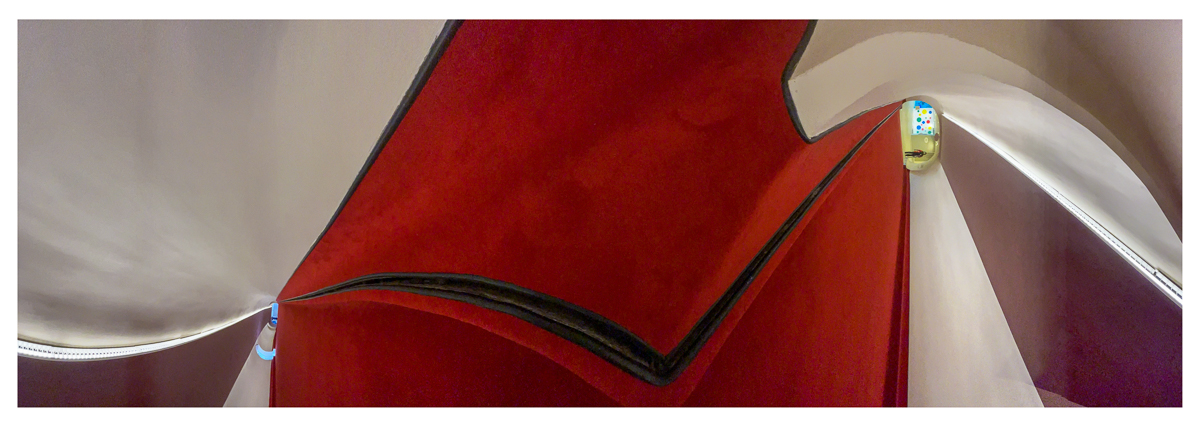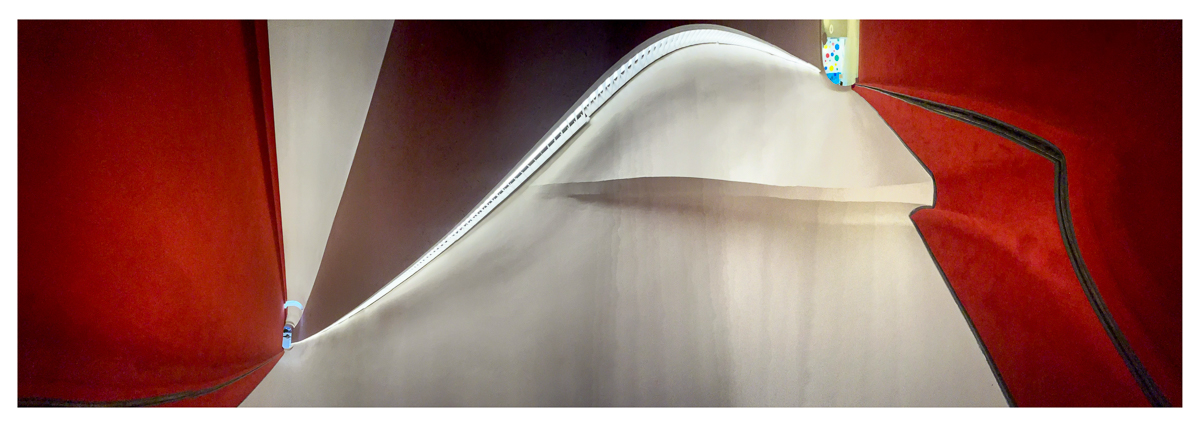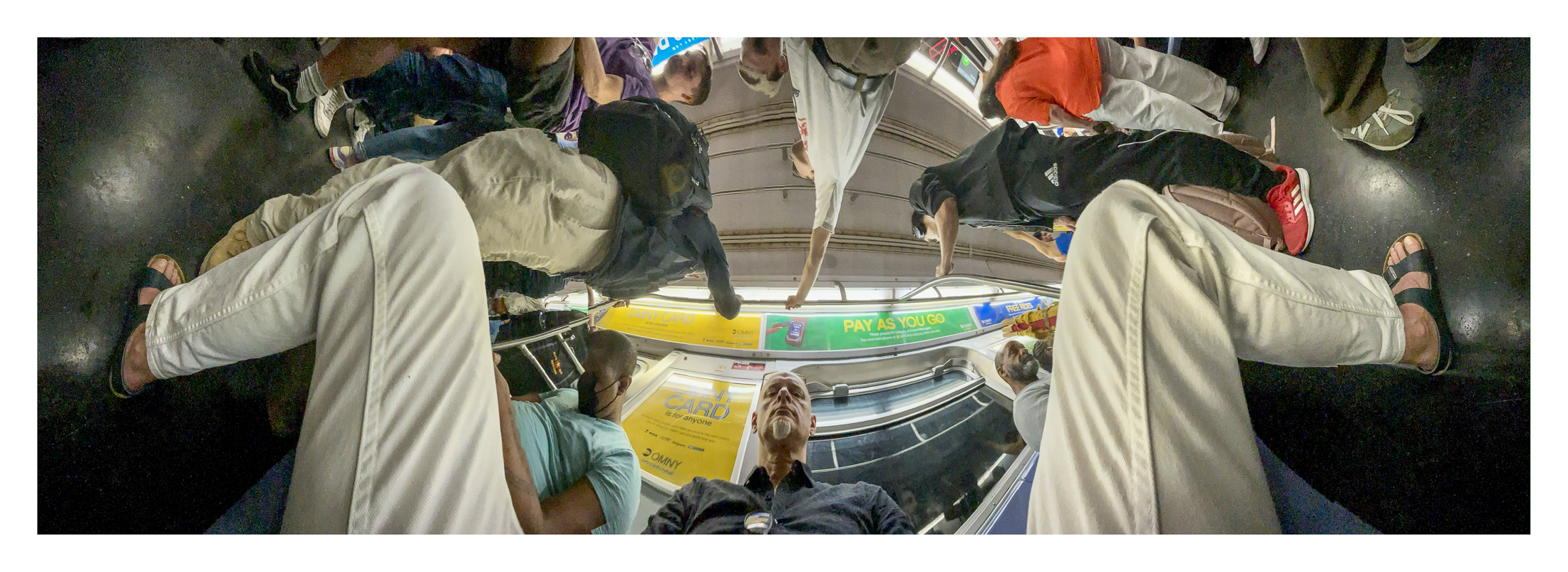ProlongancePhotography by Eric Laverty
Navigating the environment with shutter open, I capture not isolated moments but an unfolding, fluid continuum. As presence and process merge, the interplay between light and shadow, static and mobile, reveals the ephemeral that always accompanies us, yet remains beyond perception.
Through a continuous vantage point perspective I call Prolongance, I instigate and become the action in my compositions, asserting and recording my presence with a physicality that contrasts with traditional image-making practices. Like the blur, the optical flow I induce captures visual transitions and movements that are necessarily masked by the brain’s neural processing, unveiling what is ordinarily hidden from perception. This revelation of the unseen and unseeable feels magical and forms the core of my creative exploration. Yet, as Rebecca Solnit observed of Eadweard Muybridge, I seek to transcend the ubiquitous blur in photography, reimagining how motion and movement can be visualized.
I engage in a performative collaboration with my body, imaging technology, and the surrounding environment, where every step, directional shift, and fleeting encounter becomes a part of the unfolding. As I negotiate gait, balance, and direction, I respond to the environment and the cues from my camera, embracing the inherent uncertainty that guides each interaction.
The unpredictable nature of Prolongance often leads to missteps, glitches, or failures in the imaging process. Yet, these challenges are intrinsic to my practice, transforming each obstacle into an opportunity to redefine and expand the boundaries of my photographic expression. By leveraging imaging technology in unconventional ways and harnessing the unexpected, I invite viewers to question and rediscover the ephemeral nature of their own perceptions.
Eric P. Laverty - New York
Stairmaster/Stepmaster - New York (2024)
BIOGRAPHY
Eric Laverty is an artist and photographer from Detroit, MI USA. He completed his formal studies as a guest student of Gerhard Richter during the German painter's final years of tenure at the Kunstakademie Düsseldorf where fellow professors Bernd and Hilla Becher, Jan Dibbets, and Nam June Paik, along with Richter, became enduring influences on Laverty's art and creative perspective.
Prior to his 5-year German sojourn in the early '90s, Laverty studied Photography under Jim Dow at SMFA - Boston. Prior to SMFA, as he pursued a BA at the University of Michigan, Laverty was inspired to think and communicate his ideas pictorially during a seminar with Michael Taussig (now at Columbia University), and motivated to re-consider a degree in Anthropology. He dedicated his final year on University of Michigan North Campus immersed in an intensive Bauhaus-styled design and Fine Art curriculum before moving to Boston and SMFA.
Throughout his studies, Laverty continued to master and apply his skills at the forefront of computer-generated graphic design, which he began training just after high school graduation. This not only sustained his academic studies but became the backbone of a professional career in design and creative management until he shifted entirely to his first and primary medium of photography. It was at this time, while focused on architectural imaging and the built environment, Laverty began re-engaging his art practice with the introduction of Structural Catabolism (see below).
Laverty's work now fuses street and forensic photography, assemblage, selfie-ism, performance, and new approaches to time-lapse and stop-action photography. His in-camera collages cut, slice, rip, and curl; fragment, flay, straighten, and unfurl all with an emphasis on abstraction and an eye to liberate his photography from convention.
Laverty lives and works in both Brooklyn and Detroit, extending his primary studio onto the streets of NYC where his almost daily peregrinations generate troves of experimental content. His photography, photo-collages and painting have been exhibited in Boston, Düsseldorf, New York, and Brussels and are in private collections in the United States, Europe, and Japan.
Harvard Union - Cambridge, MA (1989)
FORMATIVE
From a young age, Laverty was immersed in the world of photography, though not in the way one might romanticize. His mother, an unwavering chronicler of their family’s life, approached the medium with an intensity that often eclipsed the moments she sought to preserve. Her camera, always poised to document, transformed family interactions into performances, where the act of capturing frequently superseded the act of living. This relentless prioritization of memory capture over connection cultivated in Laverty an acute awareness of the camera’s power to fracture relationships and create detachment.While Laverty deeply values the legacy of his mother’s work, her compulsions instilled in him a complex relationship with photography. He came to see it not as an act of preservation but as a force capable of shaping—and often distorting—reality. This awareness fueled his early disdain for the medium, but over time, it also inspired a desire to rethink the motivations behind its practice and to challenge its conventions as his relationship with it evolved.Today, Laverty’s work seeks to address this tension. Rather than using photography to merely fix moments in place, he approaches it as an evolving process—a collaboration between himself, the camera, and the environment. His methods transform the act of photographing from a potentially alienating experience into one of engagement, where movement, interaction, and spontaneity are woven into the image. In doing so, he aims to reclaim photography as a medium of connection, emphasizing fluidity, imperfection, and the ephemeral.This personal history underpins Laverty’s concept of Prolongance, a term that encapsulates his approach to creating durational, layered narratives. Each image is an act of reconciliation, weaving together the fractured dynamics he observed in his youth into something cohesive, alive, and profoundly human. By embracing the imperfections and contingencies inherent in the process, Laverty strives to redefine photography’s role—not as a passive observer of life but as an active participant in its unfolding..
Family Portraits - Düsseldorf (1992)
STRUCTURAL CATABOLISM
Throughout his artistic and commercial photography career, Laverty has focused on the built environment, coining the term Structural Catabolism to better describe his perspectives on space, and the layering/exposing of time and material. Borrowed from biology, Catabolism describes the breakdown of organic material during the metabolic process. In the context of the built environment, Laverty used it to describe the processes involved in demolition while he was documenting the adaptive reuse of historic structures in New York and the surrounding region. Inspired by Scarpa's exposing of the past through layering, Laverty took on a more forensic approach in his process as he bore witness to the rise of a new era in architectural sustainability and sought collaboration with real estate developers and architects with adaptive reuse ambitions.
Structural Catabolism bears witness to industrial transition, capturing the realignment of material and energy before it settles, reconfigured for the future. A process driven by contemporary motivation, characters, and technologies that resuscitate historic structures from their abandoned, decaying, or otherwise antiquated states. As Laverty elaborates, "It is only through re-engagement that the remarkable nature of these once vital structures is revealed again, and Structural Catabolism begins, inspiring a fleeting cast of shadows in its wake.”
McKim, Mead & White's Pennsylvania Railroad Power Station Demolition Phase, LIC NY (2004)
While Laverty continues to explore Structural Catabolism, he does so with a twist - figuratively and literally, as in the twisting of the camera in his ongoing 270° Phases series. He challenges his artistic assumptions, spatial awareness, and cultural impact by creating new frameworks in which to extend and redefine the picture frame. He emphasizes abstraction and the formal elements of shape, line, color, and form while embracing movement, spontaneity, and improvisation to shift and jostle perception - subverting the traditional structures and norms within the medium and engaging space and time from a unique perspective.

 270° Phases: Upstream/Downstream- TWA Airport/Hotel Connector (2022)
LOSS, PANDEMIC, AND A NEW WAY FORWARD
The devastating illness and death of his wife, followed in quick succession by the pandemic's catastrophic curbing of freedoms and his stepfather's death, plunged Laverty into a period of intense mourning that felt as though it would suffocate. He found solace during the first months of the lockdown, photographing in his backyard, immersing himself in the digitization of his wife's previously unseen drawings - distributing copies amongst friends and family, and developing his stepfather's last 50 rolls of film from Kiev. These projects opened a new dialogue with Elena and Ivan through their respective creative visions, helping begin a process of healing.
Grieving and feeling acutely unmoored, Laverty learned to breathe again and got back on his bike to seek light and levity. He found a muse in the streets of New York.
As he ventured out into the pandemic-emptied streets of 2020-21, Laverty knew he could not continue as usual. He began questioning the influence of subject matter and process in his photography as he was confronted with the ambiguous loss of NYC rhythm and vitality in its spaces and buildings - physically present, but emotionally gone (Dr. Pauline Boss, Esther Perel). But with far fewer distractions, the streets began revealing previously overlooked and less striking or relevant elements of the built environment. Without the throngs of tourists or bustle of the New York workaday, crosswalk stripes, street signage, bike paths, debris containment fields, and safety barriers came into view as equally valid elements in his compositions as were the structures he had been photographing prior to the lock-down. Elements that he so diligently sought to avoid, erase, or disguise, he now embraced.
Inspired by the motivations behind the upturned paintings of Georg Baselitz, who was surging in online appeal at the time, Laverty turned his images upside down, then began photographing with this upturned intent, freeing the shapes, colors, and forms from their conventional associations. This shift allowed him to invite comparison not only between Baselitz's post-war dystopian landscape and the disorienting nature of the pandemic, but more importantly, helped him push forward, passed the past, away from a rigid approach to image-making that would eventually lead out of the confines of traditional single-frame image capture.
Inverted Projections - New York (2020-2024)
Laverty's frequent peregrinations, bike excursions, and 'photo yoga' sessions throughout NYC and the region during this time prompted a need for greater flexibility and immediacy in his process. 'I spent so much time hopping on and off my 1976 Schwinn Continental to unpack, shoot, repack, and repeat, that the convenience and viability of my iPhone was soon tested.' This shift opened new possibilities for Laverty, allowing him to explore panoramic settings that he could only partially replicate with post-processing techniques after capture with the bulkier DSLR equipment. He also wanted to minimize post-processing in the creation of his images and learn how to create more intuitively and fluidly in the present.
Since his years at the SMFA-Boston, Laverty has been using panoramic and collaging techniques to layer space, time, and meaning, subverting the medium in the process while extending and widening his compositions and the scalability of his images. He fragmented his images by ripping, tearing, and even burning his prints, then physically stitched, glued, and taped his prints and their Xerox copies together into cohesive wholes. In the late 80s, photo-based artists like David Hockney, the Starn Twins, and Laverty himself demonstrated that these manipulations could be artful, genre-bending keys to interpreting and presenting subject matter and led to the rise and sustained use of collaging techniques in photography.
Fragmentation frequently surfaces in Laverty's work, but his practice is currently not about constructing physical assemblages or augmenting with painting, objects, and fasteners like his early experiments or as many of his contemporaries practice today. As he continues to employ necessary stitching techniques in Photoshop that extend the image frame to striking and unconventional lengths, he takes a more purist approach. His images remain solely in the realm of photography, placing him in a much different, more intense dialogue with imaging technologies, the environment, and the history of photography.
Laverty’s in-camera compositions push the boundaries of what the camera sensor can process, producing distorted, flattened, or flayed images that differ markedly in process, purpose, and possibility from traditional photography, photo-collaging, or even time-lapse and video techniques. Laverty's resulting images are playful, disarming, and at times, disorienting - yet are still records of the environment we all share.
Laverty challenges viewers' spatial awareness and encourages an experience and prolongance of their own peregrinations with perspectives that are calibrated and attuned to how we all act and interact within our shared environment - to find a more harmonious way of walking our individual paths.
 Manspreading (2024)
@ericlavertyphotography
COPYRIGHT
All images and text copyright © 1992-2025 Eric P. Laverty unless otherwise noted. All Rights Reserved. Duplication, processing, distribution, or any form of commercialization of such material beyond the scope of the copyright law shall require the prior written consent of its respective author or creator. Downloads and copies of this site and any material contained within, are permitted only for private, non-commercial use with prior consent of Eric P. Laverty.
 |
|
|
Photo courtesy Estate of Dolores T. Laverty (1968) |
|
|
|
☒
![]()
|